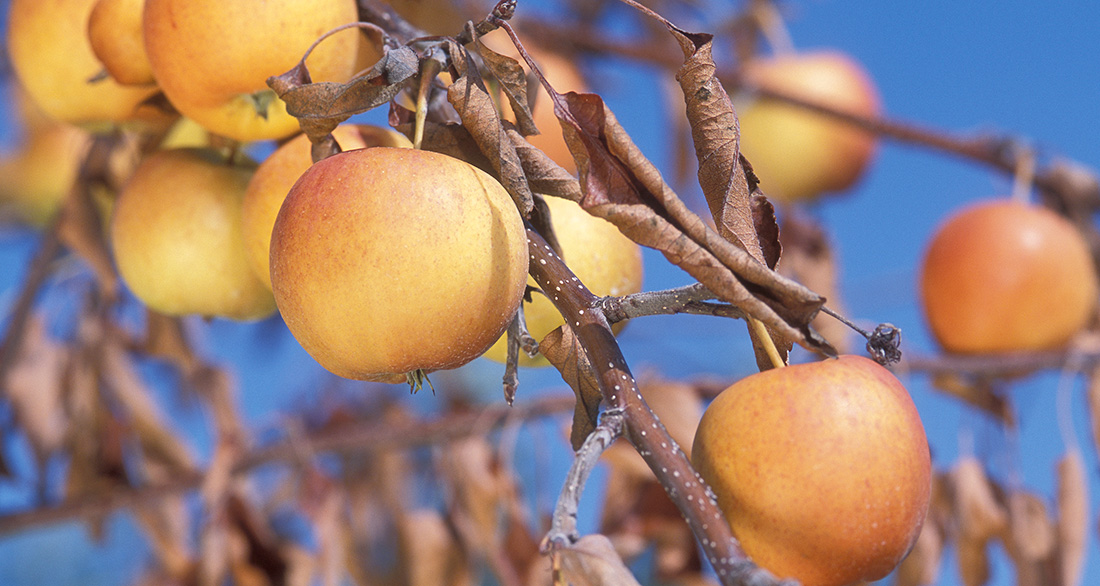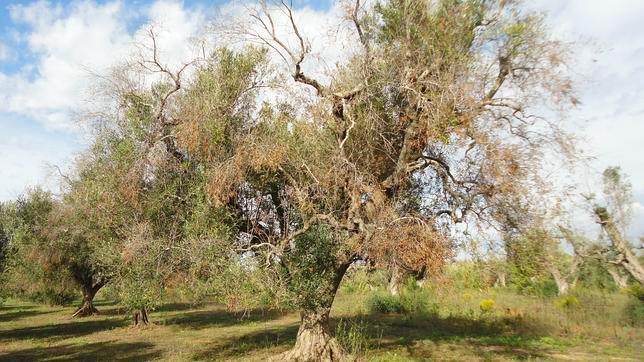BACTERIAL & VIRAL DISEASES
There are two common bacterial diseases that occur in landscapes in Los Angeles County: fire blight and diseases caused by the bacteria Xylella fastidiosa which include bacterial leaf scorch and Pierce’s Disease.
Fire Blight
Fire blight is caused by the bacterium Erwinia amylovora. It is common on apple, pear, crabapple, and pyracantha. It also occurs on cotoneaster, hawthorn, loquat, mountain ash, serviceberry, spirea, and toyon. The bacterium infects flowers, stems, and fruit. Infection in stems causes cankers which ooze brown droplets during wet weather. Insects acquire the bacteria from bleeding cankers and spread it to flowers in spring. Bees and splashing water can also spread the infection to other flowers. The infection spreads down the petiole of the flower into twigs and branches. Branches are girdled due to the infection and the branch dies beyond the point of infection. Leaves wilt and die quickly after the branch is girdled. Dead leaves remain attached to the branch resulting in dead branches scattered throughout the canopy giving a burned or blighted appearance to the tree. Infection can be extensive if it rains while the tree is blooming. The bacteria overwinter in infected cankers in branches and twigs.
Management of fire blight depends on selecting resistant varieties and quickly removing any infected branches. Application of copper and systemic fungicides during bloom can prevent new infections but will not cure existing infections. Fungicides that are effective at controlling new infections include Bordeaux powder, fixed copper, and Aliette. Applications of fungicides are not needed in the absence of rain during the blooming period.
Diseases Caused by Xylella fastidiosa (Bacterial Leaf Scorch and Pierce’s Disease)
Pierce’s disease and bacterial leaf scorch are caused by the bacteria Xylella fastidiosa (Xf). It is proving to be one of the most significant causes of plant diseases in Southern California. The bacterium is moved from plant to plant by many genera of insects such as sharpshooters, leafhoppers, and spittlebugs, which are referred to as vectors. In addition to cultivated plants and fruit trees, wild grasses, sedges, and lilies are frequent hosts in some areas as are some native bushes and trees.
Transmission of Pierce’s Disease and Leaf Scorch
Xf lives in the water conducting tissue of plants (the xylem) and is spread (vectored) from plant to plant by leafhoppers and spittlebugs. The most important insect vector in Los Angeles County is the leafhopper known as the glassy-winged sharpshooter. The glassy-winged sharpshooter was first observed in Orange County in the early 1990’s and is now well established throughout Southern California. Other sharpshooters, such as the native smoketree sharpshooter and the blue-green sharpshooter, also act as vectors, but are less efficient at doing so. The insect vectors acquire the bacteria from infected plants while feeding on the xylem sap. Once the bacterium is acquired, an adult vector retains the bacteria for the remainder of its life. The isolates of Xf from grape do not infect oleander and the isolates from oleander do not infect grape; therefore, the removal of oleanders will not prevent the infection of grapes that are nearby.
Symptoms of Pierce’s Disease and Leaf Scorch
On oleanders, leaves on one branch will turn pale green and wilt. This is quickly followed by scorching of the tips or margins of the leaves. As one branch develops symptoms and dies, other branches start showing symptoms. Since the mid-1970s, many other strains of Xf have been discovered, and almost all of these cause similar leaf scorching of woody perennials such as American elm, maple, mulberry, plum, liquidambar, olive and crepe myrtle. In some plants, such as peach, the bacterium slows and stunts the plant’s growth.
Control of Pierce’s Disease and Leaf Scorch
There are no effective controls or pesticides for diseases caused by Xf. Controlling the vector and removing infected plants has not been effective at preventing the spread of Xf to healthy grapes or oleanders. Experimental treatments with antibiotics have inhibited symptom development but are not commercially feasible. Appendix G has a list of websites containing more information on Xf diseases. In the coming years, Xf caused diseases may prove to be a major impediment to landscape managers. The County Plant Pathologist is available to help with long-term management strategies and up-to-date information.
VIRAL DISEASES
Viruses can cause a variety of symptoms in woody landscape plants. Typical symptoms include mosaic patterns in leaves, color break in flowers, stunting and distorted growth. Some species are intentionally infected with a virus to create variegated flowers such as in Camellia. Roses are commonly infected with several viruses that cause a mosaic pattern in the leaves. Viruses can be transmitted to other plants by insects, grafting, and by mechanical transmission. There are no treatments that cure or control virus infections in plants and generally treatment is not needed.



